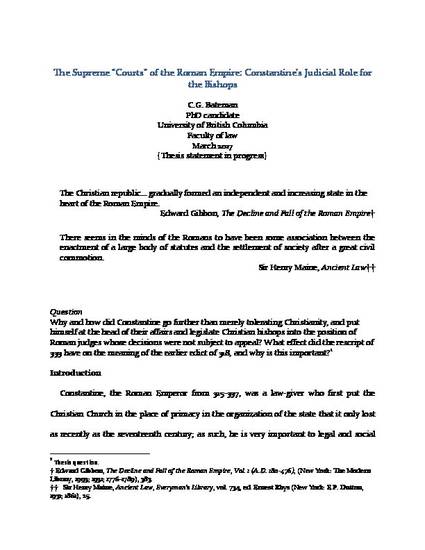
Dissertation
The Supreme "Courts" of the Roman Empire
(2018)
Abstract
Question
Why and how did Constantine go further than merely tolerating Christianity, and put himself at the head of their affairs and legislate Christian bishops into the position of Roman judges whose decisions were not subject to appeal? What effect did the rescript of 333 have on the meaning of the earlier edict of 318, and why is this important?[1]
Constantine, the Roman Emperor from 315-337, was a law-giver who first put the Christian Church in the place of primacy in the organization of the state that it only lost as recently as the seventeenth century; as such, he is very important to legal and social history in the Western experience. This thesis explores the degree to which the Emperor Constantine’s adoption and adaptation of the Christian religion’s bureaucratic structure affected the social and legal order of the Roman state bureaucracy in the fourth century: I do this by examining both the question of his legislation pertaining to making bishops judges and the legal nature of his relationship with the bishops which developed as they appealed their own decisions to his imperial court, specifically in both the Donatist and Arian crises. Constantine’s two pieces of legislation that most directly bear on this question come from 318 and 333: Codex Theodosianus (CTh) 1.27.1 and Sirmondian Constitution (Sirm.) 1, respectively. In the first, an edict, Constantine allows that any litigant may have their case transferred to a bishop’s court if they so choose, but he is careful to emphasize the right of the presiding judge to make this transfer official. In the second, a rescript, Constantine significantly expands the powers of the bishop’s as judges, and indicates that, among other things, just as with decision of the praetorian prefects, any decision of a bishop is not subject to appeal. In this way, the bishop’s court seemed to be positioned by Constantine as an appeal court of kinds, but in practice and according to the small amount of evidence we have on the subject, these courts, the episcopalis audentia, heard most legal matters as a working court of first instance, like that of any other local magistrate. The uniqueness of the court is evident not so much in their powers as judges, but in the fact that they began to hear matters between litigants applying Roman law to enforce their rights. The focus of my research is the seeming expansion of powers that Constantine gives to the bishops from the first to the second piece of legislation. The 333 rescript was actually a reply to the Prefect of Rome, Ablavius, who was questioning the use of the Edict of 318, and because of this, perhaps, we learn a great deal more about what Constantine wanted that earlier law to mean in 333, but whether he initially had this in mind is unknown since the first piece of legislation was very brief. I argue that he did not have this in mind, and that only after his relationship with the bishops grew in the intervening years, highlighted jointly by his blatant adoption of the Christian religion and subsequently assuming state responsibility for their protection and dispute settlement mechanism at the Council of Nicaea in 325, would such expansion of judicial authority make any reasonable sense. The emperor was in some ways compelled into a relationship with the Church because of the internecine conflicts within it which threatened the stability of his Empire, the two most important being the Donatist and Arian crises.
[1] Thesis question.
Keywords
- Constantine,
- Bishops,
- Late Antiquity,
- Sovereignty,
- Courts,
- Legal History,
- International Law
Disciplines
Publication Date
Winter January 17, 2018
Degree
Ph. D. candidate
Field of study
Legal history
Department
Law
Comments
This is a thesis introduction in draft form.
Citation Information
C.G. Bateman. The Supreme "Courts" of the Roman Empire. Vancouver, BC: University of British Columbia, Faculty of Law [Thesis introduction draft]. January 17, 2018.
Creative Commons license

This work is licensed under a Creative Commons CC_BY International License.